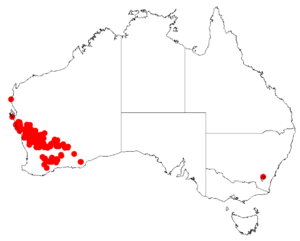Acacia andrewsii facts for kids
Quick facts for kids Acacia andrewsii |
|
|---|---|
| Scientific classification | |
| Genus: |
Acacia
|
| Species: |
andrewsii
|
 |
|
| Occurrence data from AVH | |
Acacia andrewsii is a type of shrub. It belongs to the large group of plants called Acacias, also known as wattles. This special plant grows only in Western Australia. This means it is endemic to that area.
Description of the Plant
The Acacia andrewsii is a spreading shrub. It can grow from about 0.3 to 2 meters tall. That's like growing from your knee height to taller than a grown-up! It often has prickly branches.
Its young branches are smooth or nearly smooth. They have light grey bark. Small, spine-like parts called stipules grow on the branches. These are about 1 to 1.5 millimeters long.
The leaves of this plant are not typical flat leaves. They are called phyllodes. Phyllodes are flattened leaf stems that look and act like leaves. They are stiff and green. They can be narrow and oblong, or shaped like a spear. Each phyllode is about 7 to 22 millimeters long. That's roughly the length of your fingernail to a bit longer than a coin. They are also about 1 to 2 millimeters wide. Each phyllode has a clear main vein.
This plant blooms from June to August. It produces bright yellow flowers. The flowers grow in simple, round clusters. Each cluster has about 20 to 30 golden-colored flowers.
After the flowers, curved, reddish-brown seed pods form. These pods are somewhat woody. They can be round or flattened with wide edges. The pods grow up to 6.5 centimeters long. They are about 4 to 5 millimeters wide. Inside, the seeds are oblong or oval-shaped. They are about 3.5 to 5 millimeters long.
How it Was Named
A botanist named William Vincent Fitzgerald first officially described this plant. A botanist is a scientist who studies plants. He described it in 1904. This was part of his work called Additions to the West Australian Flora. It was published in a science journal.
In 2003, another botanist, Leslie Pedley, reclassified it. This means he put it into a different plant group. He called it Racosperma andrewsii. But in 2006, it was moved back to the Acacia group.
The very first plant specimen used to describe the species is called the type specimen. It was collected by C.P.R. Andrews in 1903. This happened near Watheroo.
Where it Grows
Acacia andrewsii is found in several regions of Western Australia. These include the Mid West, Goldfields-Esperance, and Wheatbelt areas.
It likes to grow on low hills made of limestone or laterite. It can also be found among granite rocks. It grows in many different types of soil.
You can find this shrub from Kalbarri in the north. It extends south to around Nyabing. It also grows as far inland as east of Norseman. It is often part of scrublands, shrublands, or mallee communities. In areas closer to the coast, it grows in coastal heath.

